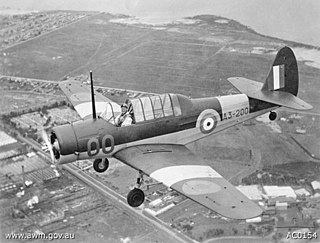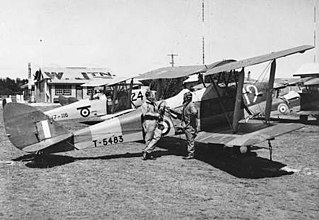Related Research Articles

RAAF Williams is a Royal Australian Air Force (RAAF) military air base set across two locations, at Point Cook and Laverton, located approximately 20 km (12 mi) south-west of the Melbourne central business district in Victoria, Australia. Both establishments previously existed as separate RAAF Bases until 1989 when they were amalgamated to form RAAF Williams. The name was chosen in honour of Air Marshal Sir Richard Williams, the 'father' of the RAAF.

The CAC Wirraway is a training and general purpose military aircraft manufactured in Australia by the Commonwealth Aircraft Corporation (CAC) between 1939 and 1946. It was an Australian development of the North American NA-16 training aircraft. The Wirraway has been credited as being the foundation of Australian aircraft manufacturing.

The CAC CA-25 Winjeel is an Australian-designed and manufactured three-seat training aircraft. Entering service with the Royal Australian Air Force (RAAF) in 1955 as a basic to advanced trainer, it served in this role until 1975. Later, it was used in the Forward Air Control (FAC) role for target marking until 1994, after which it was retired from RAAF service.

The CAC Wackett Trainer was the first aircraft type designed in-house by the Commonwealth Aircraft Corporation of Australia. The name was derived from its designer Lawrence Wackett. "In acknowledgement of the CAC Manager's enormous contribution, the RAAF were to call the aircraft the Wackett Trainer"

Sir Lawrence James Wackett is widely regarded as "father of the Australian aircraft industry". He has been described as "one of the towering figures in the history of Australian aviation covering, as he did, virtually all aspects of activities: pilot, designer of airframes and engines, entrepreneur and manager". He was knighted for his services to aviation and was a winner of the Oswald Watt Gold Medal. He was also a keen angler and wrote two books on the subject.

The de Havilland DH.60 Moth is a 1920s British two-seat touring and training aircraft that was developed into a series of aircraft by the de Havilland Aircraft Company.

Camden Airport is an aerodrome located on the outskirts of Sydney, 1 nautical mile northwest of Camden, New South Wales, Australia. The airport is located approximately 60 km (37 mi) from Sydney's central business district. Camden is used as a general aviation overflow airport for the busier Bankstown Airport, and provides facilities for gliding and ballooning. The aerodrome has one grass runway and one paved runway and two glider airstrips. It is in the south-west corner of the designated Sydney flight training area.

Netherthorpe Aerodrome is located 2 NM west by north of Worksop, Nottinghamshire, England. The aerodrome is in the Metropolitan Borough of Rotherham close to the village of Thorpe Salvin.

The de Havilland DH.94 Moth Minor was a 1930s British two-seat tourer/trainer aircraft built by de Havilland at Hatfield Aerodrome, England. With the start of the second world war production of the Moth Minor was moved to de Havilland Australia at Bankstown Aerodrome, Australia.
Horn Island Airport is an international airport on Horn Island in the Torres Strait, Queensland, Australia.

Shellharbour Airport, formerly Illawarra Regional Airport, also referred as Albion Park Aerodrome or Wollongong Airport, is an airport located in Albion Park Rail, New South Wales, Australia.

Toowoomba City Aerodrome is an airport located 2.2 nautical miles northwest from the CBD of Toowoomba, Queensland, Australia. Toowoomba City Aerodrome is both licensed and certified. The aerodrome is owned and operated by Toowoomba Regional Council. Being certified means the airfield is able to have airlines and larger charter aircraft operate from the aerodrome. Being licensed means that the aerodrome is regulated by federal transport security regulations. Toowoomba City Aerodrome does not have a control tower; however the airfield is regulated and operated under Civil Aviation Safety Authority (CASA) regulations of aviation operations at non-tower controlled aerodromes.

Temora Airport is a small airport located 2 nautical miles northwest of Temora, New South Wales, Australia. Currently no regularly scheduled passenger fights serve the airport. The current owner, the Temora Shire Council, do not charge landing fees for aircraft to use the facility, encouraging a wide variety of general aviation uses, including skydiving, gliding, flight training, kit aircraft assembly and aircraft maintenance. It is also the home of the Temora Aviation Museum, and hosts regularly flying displays and events.
Scone Memorial Airport, is a public airport in the Upper Hunter Valley, 4 km (2.5 mi) northwest of Scone, New South Wales, Australia. It was built to provide a public aerodrome replacing Nandowra aerodrome on located on "Nandowra", approx. 9 km south of Scone.
Tugan Aircraft Ltd. was an Australian aircraft manufacturer of the 1930s. It was based at Mascot aerodrome, now Sydney Airport. It is best known for having manufactured the Gannet, the first Australian-designed aircraft to enter series production.

No. 4 Elementary Flying Training School was a Royal Australian Air Force (RAAF) pilot training unit that operated during World War II. It was one of twelve elementary flying training schools employed by the RAAF to provide introductory flight instruction to new pilots as part of Australia's contribution to the Empire Air Training Scheme. No. 4 EFTS was established in January 1940 at Mascot, New South Wales, and initially operated in conjunction with civilian flying organisations based at Mascot and Newcastle. The school was disbanded in April 1942, and its operations transferred to No. 6 Elementary Flying School at Tamworth.

Maylands Airport on the Maylands Peninsula, in Maylands, Western Australia, was the main landing place of a significant number of record breaking flights in the early stages of flight in Australia. It was Perth's first official airport and was the birthplace of commercial aviation in Western Australia.
Maitland Airport, also known as Russell Field is a general aviation airport located in the suburb of Rutherford, approximately 5 km (3.1 mi) from Maitland in the Australian state of New South Wales. There are currently no airline services, with the airfield catering mostly to general aviation and recreational category aircraft. The airport has been owned and operated by the Royal Newcastle Aero Club since 1963 and shares a large training area with the nearby Cessnock Airport. Throughout its history, the airport has played host to many airshows, races and flying competitions. The field is named for the fifth President of the Royal Newcastle Aero Club, Robert Russell, who suffered a fatal heart attack while on the premises in 1966.

No. 7 Elementary Flying Training School was a Royal Australian Air Force (RAAF) pilot training unit that operated during World War II. It was established in August 1940 at Western Junction Aerodrome, Tasmania, and provided introductory flying training to new RAAF pilots. Training activities ceased in December 1944, and the unit was disbanded in August the next year.
Cramlington Aerodrome was a military airfield established in Northumberland during the First World War. It became a civil airfield serving the Tyneside area of north-east England and operated until 1935, when it was replaced by Woolsington Airport, now known as Newcastle International Airport.